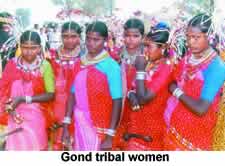
Dimdima
Online Children's Magazine from India

Dimdima
Online Children's Magazine from India

The banks of the Narmada river in Mandla district are inhabited mainly by the Baiga and Gond tribes. The Gonds are one of the most ancient tribes or adivasis of India. They are found in all the areas south of the Vindhyas, but are especially numerous in Madhya Pradesh and Chhatisgarh. In Madhya Pradesh, they are concentrated in the plateau region.
The Gonds were long ago hunter-gatherers, but now they depend almost completely on agriculture. Though some are landowners, today, the majority have been reduced to working on others’ farms as wage labourers. Over the centuries, the forests and hilly tracts which they considered as theirs by right as original inhabitants, have been encroached upon by settlers from the plains. They have also lost land to moneylenders as repayment for debts. Large areas have been taken away by the government for the Narmada Sagar Project, while still more land has been inundated by the overflow from the completed dams in the Narmada. A simple, innocent and illiterate people with few wants, the Gonds have been mercilessly exploited like many other tribal societies around the globe.
The modern world has intruded into their sylvan retreats, so much so, that many of them have forgotten to speak Gondi and converse in Hindi instead. They have also given up some of their unique customs including the worship of tribal gods.
One of the more popular dances among the Gonds which they still trot out for visiting VIPs, is the karma. Karma is the name of a plant that is commonly found in the area. Before the ceremonial dance begins, a stalk of the plant, called karam kalla is buried in the ground. The dancers gyrate around the stalk. Flowers, curd and rice are offered. Blades of yellow barley seedlings are given to young boys and girls to wear in their hair.
Normally, the karma is erformed when the rains are at their heaviest. That is when the transplanting of paddy is done and the harvest is not yet ready and there is time for celebration.
The Englishman Verrier Elwin was dubbed a ‘philanthropologist’ for his selfless work among tribals. He lived with the  Gonds in Karanjia, a small village in Mandla district, 17 km from Amarkantak. Elwin trained for missionary work and chose India to work in because many of his family members had lived and served there. He arrived in India in the late 1920’s, when he was barely 25, as a member of the Christa Seva Sangha, which was modelled on Gandhian principles. After a few years, Elwin decided to work with the tribals in Central India and came to Karanjia in 1932 along with an Indian associate Shamrao Hivale. They set up an ashram there. Soon, they had opened a leper refuge, a school and a dispensary. Elwin and Hivale eventually set up eight branch ashrams in the area to serve the tribals. Gonds in Karanjia, a small village in Mandla district, 17 km from Amarkantak. Elwin trained for missionary work and chose India to work in because many of his family members had lived and served there. He arrived in India in the late 1920’s, when he was barely 25, as a member of the Christa Seva Sangha, which was modelled on Gandhian principles. After a few years, Elwin decided to work with the tribals in Central India and came to Karanjia in 1932 along with an Indian associate Shamrao Hivale. They set up an ashram there. Soon, they had opened a leper refuge, a school and a dispensary. Elwin and Hivale eventually set up eight branch ashrams in the area to serve the tribals.So involved did Elwin become with the Gonds that he even married a Gond woman, Kosi, whom he later divorced. Leila, the second woman he married, was also a tribal. The tribals revered him as ‘bade bhai’ (elder brother). Even though he was not a qualified anthropologist, Elwin wrote many authoritative books about the tribals which are read by anthropologists even today. He became an Indian citizen and in 1954 he was appointed Adviser for Tribal Affairs in the Northeast. In 1961 Elwin was awarded the Padma Bhushan. He died of a heart attack in Delhi in 1964. Neither the thick forests of Elwin’s time nor his ashram, built in Gond style, exist in Karanjia today. His tribal world has all but vanished. |
Last updated on :12/5/2005
Dimdima is the Sanskrit word for ‘drumbeat’. In olden days, victory in battle was heralded by the beat of drums or any important news to be conveyed to the people used to be accompanied with drumbeats.
Bharatiya Vidya Bhavan
K. M Munshi Marg,
Chowpatty, Mumbai - 400 007
email : editor@dimdima.com
Bharatiya Vidya Bhavan
505, Sane Guruji Marg,
Tardeo, Mumbai - 400 034
email : promo@dimdima.com
Dimdima.com, the Children's Website of Bharatiya Vidya Bhavan launched in 2000 and came out with a Printed version of Dimdima Magazine in 2004. At present the Printed Version have more than 35,000 subscribers from India and Abroad.